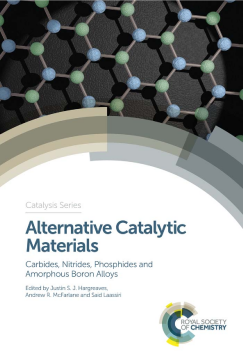
BOOK
Alternative Catalytic Materials
Justin S J Hargreaves | Andrew R McFarlane | Said Laassiri
(2018)
Additional Information
Book Details
Abstract
Many important industrial chemical processes rely heavily on catalysis and so researchers are always on the lookout for alternative catalytic materials that may improve existing processes or lead to new ones. Families of alternative catalytic materials currently being investigated include the carbides, nitrides and phosphides as well as amorphous boron catalysts. The addition of carbon, nitrogen or phosphorous to transition metals and the creation of boron-transition metal alloys leads to catalytic materials that have interesting properties, with applications in a range of different reactions, including electrocatalysis.
This book provides a comprehensive account of the preparation, characterisation and application of these catalytic materials. It is an important reference for researchers and industrialists working in heterogeneous catalysis and materials chemistry.
Table of Contents
| Section Title | Page | Action | Price |
|---|---|---|---|
| Cover | Cover | ||
| Preface | vii | ||
| Contents | ix | ||
| Chapter 1 Introduction to the Application of Nitrides, Carbides, Phosphides and Amorphous Boron Alloys in Catalysis | 1 | ||
| 1.1 Introduction | 1 | ||
| 1.2 Hydrogenation Reactions | 3 | ||
| 1.3 Hydrotreating Reactions | 6 | ||
| 1.4 Synthesis Gas Production | 12 | ||
| 1.5 Synthesis Gas Conversion | 14 | ||
| 1.6 Ammonia and Hydrogen | 17 | ||
| 1.7 Electrocatalysis | 19 | ||
| 1.8 Conclusions | 20 | ||
| References | 20 | ||
| Chapter 2 Preparation Methods for Nitride and Carbide Catalysts | 27 | ||
| 2.1 Introduction | 27 | ||
| 2.1.1 NH3/CxHy-TPR | 28 | ||
| 2.1.2 Elemental Direction Nitridation/Carburisation in the Presence of H2 | 31 | ||
| 2.1.3 Thermal Decomposition of Metal–Amine Complexes or Gels | 33 | ||
| 2.2 Catalytic Applications | 35 | ||
| 2.3 Conclusion | 41 | ||
| Acknowledgements | 41 | ||
| References | 42 | ||
| Chapter 3 Metal Phosphides and Their Applications in Catalysis | 46 | ||
| 3.1 Introduction | 46 | ||
| 3.2 Synthesis Methods | 48 | ||
| 3.2.1 Temperature Programmed Reduction (TPR) | 49 | ||
| 3.2.2 Metal Complex Decomposition | 51 | ||
| 3.2.3 Other Methods | 54 | ||
| 3.3 Catalytic Applications | 54 | ||
| 3.3.1 Hydrotreating | 54 | ||
| 3.3.2 Biomass Conversion | 59 | ||
| 3.3.3 Electrocatalytic Hydrogen Evolution Reaction (HER) | 61 | ||
| 3.3.4 Other Reactions | 64 | ||
| 3.4 Conclusions and Future Outlook | 64 | ||
| Acknowledgements | 65 | ||
| References | 65 | ||
| Chapter 4 Metal Carbide Catalysts | 71 | ||
| 4.1 Introduction | 71 | ||
| 4.2 Syngas Related Reactions | 72 | ||
| 4.3 Hydroprocessing, Selective Hydrogenation and Dehydroaromatisation | 74 | ||
| 4.4 Ammonia Decomposition | 76 | ||
| 4.5 The Hydrogen Evolution Reaction and the Oxygen Evolution Reaction | 78 | ||
| 4.6 Conclusion | 79 | ||
| References | 80 | ||
| Chapter 5 Metal Nitride Catalysts | 84 | ||
| 5.1 Introduction | 84 | ||
| 5.2 Ammonia Synthesis and Related Reactions | 85 | ||
| 5.3 Selective Hydrogenation and Related Reactions | 94 | ||
| 5.4 Conclusion | 97 | ||
| References | 98 | ||
| Chapter 6 Amorphous Boron Alloys and Their Catalytic Behaviour | 104 | ||
| 6.1 Introduction | 104 | ||
| 6.2 Preparation of Amorphous Boron Alloys | 104 | ||
| 6.3 Catalytic Activity of Amorphous Boron Alloys | 109 | ||
| 6.4 Conclusions | 118 | ||
| References | 118 | ||
| Chapter 7 Alternative Materials for Chemical Looping Applications | 120 | ||
| 7.1 Introduction | 120 | ||
| 7.2 Development of Nitride Materials for Chemical Looping Applications | 123 | ||
| 7.3 Concluding Remarks | 129 | ||
| References | 129 | ||
| Chapter 8 Applications of Transition Metal Nitrides as Electrocatalysts | 133 | ||
| 8.1 Introduction | 133 | ||
| 8.2 The Electrolysis of Water | 135 | ||
| 8.2.1 The Hydrogen Evolution Reaction | 135 | ||
| 8.2.2 The Oxygen Evolution Reaction | 142 | ||
| 8.3 Fuel Cell Reactions | 145 | ||
| 8.3.1 The Oxygen Reduction Reaction | 145 | ||
| 8.3.2 Hydrogen and Methanol Oxidation Reactions | 151 | ||
| 8.4 Electrocatalytic Ammonia Synthesis | 152 | ||
| 8.5 Conclusion | 157 | ||
| References | 158 | ||
| Chapter 9 Electrocatalysis with Metal Phosphides | 164 | ||
| 9.1 Introduction | 164 | ||
| 9.2 Synthesis of Metal Phosphides | 165 | ||
| 9.2.1 Bulk Particles | 166 | ||
| 9.2.2 Nanostructures | 166 | ||
| 9.3 Application of Metal Phosphides | 170 | ||
| 9.3.1 Electrolysis of Water | 170 | ||
| 9.3.2 Simulation | 174 | ||
| 9.3.3 Stability of Metal Phosphides | 178 | ||
| 9.3.4 Other Applications | 181 | ||
| 9.4 Final Remarks | 182 | ||
| References | 183 | ||
| Chapter 10 Concluding Remarks | 186 | ||
| References | 189 | ||
| Subject Index | 191 |
